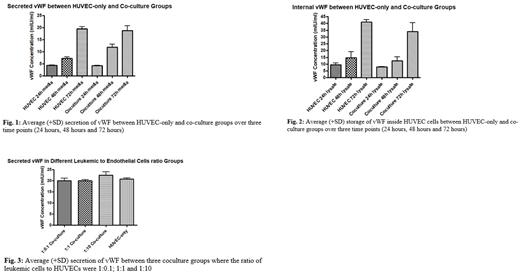Abstract
Background: Acute lymphoblastic leukemia (ALL) is the most common cause of cancer and death from cancer among children, with an incidence of 1 in 1,750 children. A previous Dutch cohort study highlighted that 7.6% of children with ALL also developed venous thromboembolism (VTE; n=55/778). VTE increases the risk of morbidity and mortality in cancer patients. However, the mechanisms of hemostatic abnormality in ALL is not well understood. Von Willebrand factor (vWF) is involved in thrombosis and is a well-established marker for endothelial dysfunction. High vWF levels and qualitative abnormality of the protein have been documented in patients with ALL and may contribute to the prothrombotic state observed in these patients.
Objective: To determine whether co-culturing cancerous ALL cells with healthy human umbilical vein endothelial cells (HUVECs) may increase vWF secretion from endothelial cells.
Methods: HUVECs were obtained from Lonza Bioscience Solutions (Basel, Switzerland) and leukemic B-lymphoblasts (ALL cells) derived from bone marrow were obtained from ATCC (Manassas, Virginia, USA). Passages 3 to 5 were used in this study and cell lines were grown as per manufacturer's instruction. A confluent monolayer of HUVECs was established before the co-culturing experiments. Firstly, ALL cells and HUVECs were grown together (co-cultured) at a 1:1 ratio. Then, the conditioned media and cell lysates were harvested at three different time points and the vWF levels were quantitated by a vWF-ELISA. To further evaluate the effect of leukemic cells on the endothelium, ALL cells were also co-cultured at a 10:1 ratio to endothelial cells. All experiments were conducted in biological triplicates.
Results: Cells were monitored throughout the study period and no morphological changes to the endothelial cells were observed. An accumulation of vWF was recorded over time in both the conditioned media and cell lysates. The differences in vWF levels between the co-culture group and HUVEC-only group at three time points (24, 48 and 72 hours) were not statistically significant. In addition, 10-fold differences in ratio between leukemic and endothelial cells did not have a meaningful effect on vWF levels.
Discussions: In an in vitro co-culture system, ALL cells do not appear to induce an increase vWF secretion in HUVECs. Contrary to prior evidence, this study suggests that increased vWF secretion from endothelial cells may not be a contributor to the prothrombotic state observed in ALL. The circulating lymphoblasts may have a more pronounced effect on other endothelial layers where vWFs are highly expressed such as the pulmonary endothelium. On the other hand, peripheral blood pediatric leukemic lymphoblasts have been demonstrated to produce hemostatic factors, which may contribute the hemostatic imbalance in the progression of disease. In addition, the pathogenesis of thrombosis in ALL is likely to be therapeutically related since thrombosis rarely occurs at presentation. Alternative mechanisms, such as ADAMST13 and hemostatic factors' level and function or the use of chemotherapeutic agents, ought to be explored.
Matino: Bayer: Membership on an entity's Board of Directors or advisory committees, Other: research grants and personal fees; Pfizer: Membership on an entity's Board of Directors or advisory committees, Other: research grants and personal fees; Novo Nordisk: Membership on an entity's Board of Directors or advisory committees, Other: research grants and personal fees; Sanofi: Membership on an entity's Board of Directors or advisory committees, Other: research grants and personal fees; Spark: Other: research grants; Octopharma: Membership on an entity's Board of Directors or advisory committees, Other: research grants and personal fees; Sobi: Membership on an entity's Board of Directors or advisory committees, Other: personal fees.


